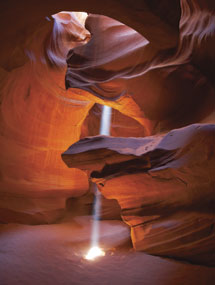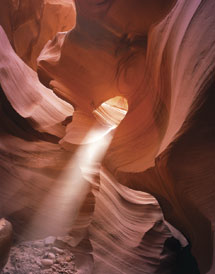Mastering Photographic Composition, Creativity, And Personal Style Page 2
Light Shaft – #1 |
 |
Light Shafts
Light shafts provide unique photographic opportunities because they occur in places that are by definition dark. Even though they may look very bright, light shafts are actually not all that bright. It is the darkness that surrounds them that makes them stand out.
Light shafts can occur in a variety of locations. However, for a light shaft to be visible three conditions are necessary. First, direct sunlight must reach that location. Second, the ambient light must be dark enough for the light shaft to be visible. Third, and most important, dust, sand, smoke or other particulates must be suspended in the air. This third condition is an absolute requirement, because without it the light shaft will not be visible. If there are no particulates in the air, all you will see is a spot of light on the floor showing where the light shaft ends.
Light Shaft – #2 |
 |
In slot canyons light shafts can occur naturally on a windy day if sand is floating in the air, carried upwards by the wind. But how do you make a light shaft appear in a slot canyon when no dust or sand is floating in the air? Simple! Take a handful of sand and throw it up in the air into the location of the light shaft. As soon as the sand or the dust is in the air, the light strikes the particles and as if by magic a light shaft appears in front of your eyes. With practice you will learn exactly how much sand you need to throw, as well as how high you need to throw it, to create the perfect light shaft.
If there is an upward air draft in the location of the light shaft, you can kick sand with your feet to make it rise towards the light shaft. The air current will carry the sand into the light shaft and you won’t need to throw it. This works only when the air is blowing upwards, which is not always the case. The rest of the time you need to rely on the tried and true “sand throwing” method.
Light Shaft – #3 |
 |
Light shafts add an exciting visual element to your compositions. They are dynamic elements that are both intangible and ever changing. Because they form straight lines, they can be used as compositional leading lines or as diagonal lines. They can even be used to show perspective since the far end of the light shaft is narrower than the end nearby.
Alain Briot is one of the leading contemporary landscape photographers. Originally from Paris, France, he attended the Academie Nationale des Beaux Arts in Paris where he studied drawing and oil painting. Briot began studying photography in 1980. Currently living in Arizona with his wife Natalie, his favorite photographic locations are in the Southwestern US.
Briot is a columnist for the Luminous Landscape website.
 |
Info & Where To Buy
Mastering Photographic Composition, Creativity, and Personal Style by Alain Briot
ISBN: 978-1-933952-22-2
August 2009
List price: $44.95
Published by Rocky Nook (www.rockynook.com)
Rocky Nook’s books are distributed by O’Reilly Media and can be purchased from their website at: http://oreilly.com.
- Log in or register to post comments

















































